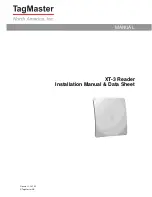
DMU380SA Series
User’s Manual
________________________________________________________________________
Doc# 7430-0026 Rev.01
Page 29
The VG380SA outputs digital measurement data over the RS-232 serial link at a
selectable fixed rate (100, 50, 25, 20, 10, 5 or 2 Hz) or on as requested basis using the
GP, ‘Get Packet’ command.
In addition to the scaled sensor packets described in the
IMU380SA section, the VG380SA has additional measurement output packets including
the default ‘A2’ Angle Packet which outputs the roll angle, pitch
angle, and digital IMU
data.
‘N0’ and ‘N1’ packets are also available for use with an external GPS receiver.
See
Section 6 and 7 of the manual for full packet descriptions.
4.3.1
VG380SA Advanced Settings
In addition to the configurable baud rate, packet rate, axis orientation, and sensor low-
pass filter settings, the VG380SA provides additional advanced settings which are
selectable for tailoring the VG380SA to a specific application requirements. These
VG380SA advanced settings are shown in Table 10 below:
Table 10.
VG380SA Series Advanced Settings
Setting
Default
Comments
Baud Rate
38,400
baud
9600, 19200, 57600 also available
Packet Type
A2
S1, N0, N1 also available
Packet Rate
25Hz
This setting sets the rate at which selected Packet Type, packets are output. If polled
mode is desired, then select Quiet. If Quiet is selected, the VG380SA will only send
measurement packets in response to GP commands.
Orientation
See
Fig. 12
To configure the axis orientation, select the desired measurement for each axes: NAV-
VIEW will show the corresponding image of the VG380SA, so it easy to visualize the
mode of operation. See Section 8.4 Orientation Field settings for the twenty four possible
orientation settings. The default setting points the connector AFT.
Filter
Settings (5,
10, 20, 50 Hz)
20 Hz
The low pass filters are set to a default of 5Hz for the accelerometers, and 20 Hz for the
angular rate sensors. There is one filter setting for all three angular rate sensors. There
are two settings for the accelerometers, one for the X and Y axes, and a separate setting
for the Z axis. The reason for a separate setting in the Z-axis is that in many installations,
the Z-axis vibration level is much higher than in the X and Y axes, and it can prove helpful
to filter the Z-axis at a lower cutoff than the X and Y axes.
Freely
Integrate
OFF
The Freely Integrate setting allows a user to turn the VG380SA
into a ‘free gyro’.
In free
gyro mode, the roll, pitch and yaw are computed exclusively from angular rate with no
kalman filter based corrections of roll, pitch, or yaw. When turned on, there is no coupling
of acceleration based signals into the roll and pitch. As a result, the roll, pitch, and yaw
outputs will drift roughly linearly with time due to sensor bias. For best performance, the
Freely Integrate mode should be used after the algorithm has initialized. This allows the
Kalman Filter to estimate the roll and pitch rate sensor bias prior to entering the free gyro
mode.
Upon exiting the ‘free gyro’ mode
(OFF), one of two behaviors will occur
(1)
If the VG380SA has been in freely integrate mode for less than sixty seconds,
the algorithm will resume operation at normal gain settings
(2)
If the VG380SA has been in freely integrate mode for greater than sixty
seconds, the algorithm will force a reset and reinitialize with high gains
automatically.
Restart On
Over Range
OFF
This setting forces an algorithm reset when a sensor over range occurs i.e., a rotational
rate on any of the three axes exceeds the maximum range. The default setting is OFF for
the VG380SA. Algorithm reset returns the VG380SA to a high gain state, where the
VG380SA rapidly estimates the gyro bias and uses the accelerometer feedback heavily.
This setting is recommended when the source of over-range is likely to be sustained and
potentially much greater than the rate sensor operating limit. Large and sustained angular
rate over-ranges result in unrecoverable errors in roll and pitch outputs. An unrecoverable
error is one where the EKF can not stabilize the resulting roll and pitch reading. If the
over-ranges are expected to be of short duration (<1 sec) and a modest percentage over
the maximum operating range, it is recommended that the restart on over range setting
be turned off. Handling of an inertial rate sensor over-range is controlled using the
restartOnOverRange switch. If this switch is off, the system will flag the overRange status
flag and continue to operate through it. If this switch is on, the system will flag a
















































